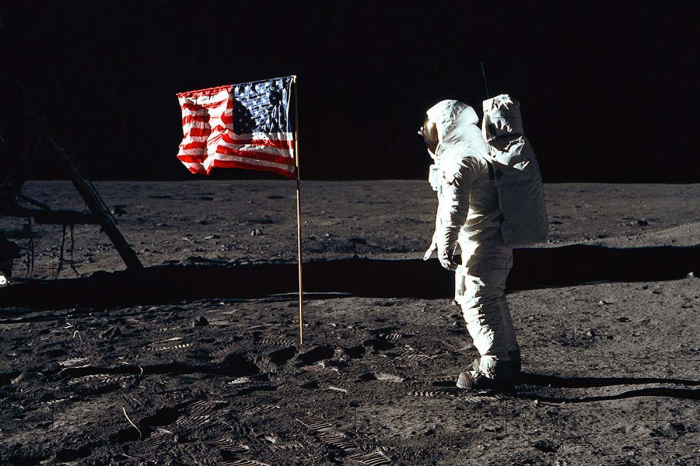The Apollo programme took humanity to the Moon but also changed the face of technology back here on Earth.
Astronaut Mike Massimino was six years old when Neil Armstrong and Buzz Aldrin took their first steps on the Moon in 1969.
"That's what inspired me to go into space," Massimino says. "I remember thinking very clearly that this was the most important thing that has happened in hundreds of years."
"I idolised those astronauts and wanted to grow up to be like Neil Armstrong," he says, "which really wasn't in the cards because I don't like heights."
After graduating with a PhD in mechanical engineering from the Massachusetts Institute of Technology (MIT), Massimino was selected as a Nasa astronaut in 1996. Over two missions, he spent more than 30 hours spacewalking to repair the orbiting Hubble Space Telescope (you can listen to a radio programme I made about Hubble here) with the Earth spinning some 535km (332 miles) beneath him. Not bad for someone with a fear of heights.
It's impossible to say if Hubble – and its vast scientific achievements – would have existed without the Apollo Moon landing programme. Apollo certainly revolutionised and accelerated space technology along with our ability to live and work in space. But, perhaps more significantly, Massimino is among a generation of children who – thanks to watching astronauts walk on the Moon – were inspired to become scientists, engineers or astronomers. People who have helped develop new cancer treatments, designed the smartphone and built Hubble.
For anyone with any degree of aspiration, the Moon landing is hard to beat. If we can put a man on the Moon, we can surely cure malaria, fix the potholes in the road or nail that presentation. It's not rocket science, after all.
But inspiration alone is probably not enough to justify the estimated $25.8bn (£20.6bn) – equivalent to around $257bn ($205bn) today – spent sending men to the Moon. A raft of inventors and entrepreneurs also owe their success to something much more tangible from the space programme of the 1960s: advances in computing.
"Apollo was the moment that people stopped talking about how big their computers were and started bragging about how small they were," says David Mindell, professor of the history of engineering and manufacturing at MIT and author of a book on the Apollo Guidance Computer.
Around the size of a small suitcase, with a separate display and input panel fitted to the main spacecraft console, the guidance computer was a marvel of miniaturisation. With the equivalent of only around 74KB ROM and 4KB RAM memory (an iPhone 14 has more than a million times as much memory), it enabled astronauts to navigate the roughly 380,000km (236,000 miles) from the Earth to the Moon and then descend to a precise spot on the lunar surface.
"The Apollo Guidance Computer was the first computer that people staked their lives on – a digital computer in the loop of the thing that they were flying," says Mindell. "That was a very important moment of showing people that computers could be reliable and could be built into things."
That concept led to Nasa's subsequent development in the early 1970s of fly-by-wire technology now fitted to almost every modern aircraft. Instead of employing mechanical links that included cranks, pulleys and hydraulics, today flight controls are electronic and coordinated by computer systems. The first Nasa prototypes even used a spare Apollo guidance computer.
Miniaturisation ultimately led to personal computers and smartphones. But it was also the sheer scale of the Apollo programme that helped transform computing technology, driving down costs and putting it – literally – in our hands.
For everything from mission control to the complex technology needed to keep the giant Saturn V rocket on track, Nasa was hungry for the latest silicon-chip tech.
"The Apollo programme was at one point in the 1960s consuming 60% of the integrated circuit output of the United States, that's a huge boost to a technology," says Mindell.
"Integrated circuits were radical, new, wacky stuff, the fact that Nasa was incorporating them into the Apollo mission was a huge boost to the legitimacy of the technology," says Mindell. "I just don't think you can possibly imagine the technological value of having something that a billion people watch succeed and what that does to legitimise new technology."
In fact, there are few areas of engineering where Apollo did not have a lasting impact. Hardly surprising when you consider just how much the United States invested in landing 12 people on the Moon.
"At one point, it reached over 4% of the federal budget, hundreds of thousands of people and roughly 20,000 companies and universities contributed to the Apollo programme," says Teasel Muir-Harmony, curator of the Apollo Collection at the Smithsonian National Air and Space Museum in Washington DC.
From innovative materials and electronics, to ready meals and the countertop microwaves to cook them in, Apollo pushed technology to its limits.
"It's a great example of the potential impact of making a technological programme a major national priority, and we see its impact on so many different areas of life," Muir-Harmony says.
That multi-billion-dollar investment also led to wider economic benefits and not only in the US. The vast majority – 94% – of those working on Apollo were contractors.
"I was giving a tour [in the Smithsonian] yesterday and pointing out how the astronauts used Gillette razors in space, and so dollars were going to all sorts of companies, supporting the American economy and the global economy to a lesser extent," says Muir-Harmony. "Hasselblad cameras developed in Sweden are a great example, so there was an investment in industry both through the labour force and through the use of many products."
In the 1960s, the over-riding political imperative was to beat the Soviet Union to the Moon at any cost, so few kept track of the wider economic benefits of Apollo. These days, Nasa is much more aware of the need to justify the effort to return humans to the Moon with the Artemis programme and is keen to show how it is spreading the love across the nation. Although the budget is a fraction of that devoted to Apollo ($32.37bn in the 2023 fiscal year), Nasa's latest economic report claims that the lunar programme has already produced $20.1bn (£16bn) in total economic output and supported more than 93,700 jobs across the US.
Back in the Apollo days, it was also the nature of some of those jobs that helped make lasting changes to US society. When the space race got underway in the late 1950s, the southern states of the US still enforced racist laws that segregated black and white Americans. African Americans were barred from living in certain areas, accessing services such as libraries or swimming pools, there were even separate rest rooms and allocated areas in restaurants.
Thanks to the book and later film, Hidden Figures, we now know the crucial role played by a team of African-American women including Katherine Goble Johnson, Dorothy Vaughn and Mary Jackson who worked at Nasa computing spacecraft trajectories. But employing people of colour in the space programme was part of a wider effort that came from the top. Segregation formally ended when President Lyndon Johnson signed the 1964 Civil Rights Act but even before that he saw Nasa as a means of pushing reform.
"While [President] Kennedy often pushed this message of global unity, tied to American leadership, tied to American scientific and technological might and capability…" says Muir-Harmony, "Johnson saw it as a way to address American civil rights issues and overcome poverty by creating jobs."
At Nasa's Marshall centre in Alabama, where the Saturn V rocket was being developed, there was a programme to actively recruit African Americans into the space programme. Elsewhere, black scientists and engineers were encouraged to work for the agency and student placement programmes with historically black colleges were started.
But Kennedy was also right. Apollo proved the capabilities of the US to the world and the missions also showed us the world. A blue and green marble against the blackness of space, an Earth without boundaries which galvanised the environment and peace movements. (Learn more about the Earthrise photo and how it sparked an environmental movement.)
Massimino retired from Nasa in 2014 and is now senior adviser for space programmes at the Intrepid Sea, Air and Space Museum in New York, a university professor and had, until recently, been a recurring character in the Big Bang Theory TV comedy show. Despite his own impressive accomplishments, Massimino still shares the views of his six-year-old self.
"I still think Apollo is the most significant thing that's happened in my lifetime and I think it's the most significant thing that will accomplish in hundreds of years," he says. "I don't know when we're going to ever come close to topping what they did going to the Moon for the first time."
BBC
More about:
















































